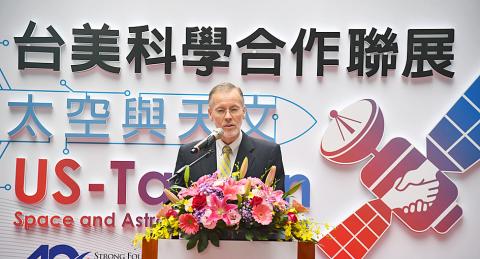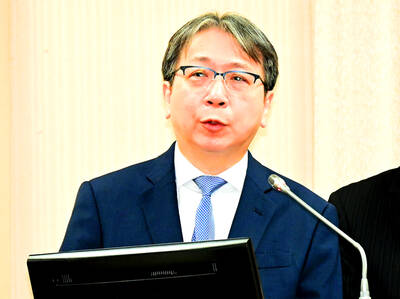American Institute in Taiwan (AIT) Director Brent Christensen yesterday unveiled a joint Taiwan-US space and astronomy exhibition at the Taipei Astronomical Museum, part of a series of events organized to mark the 40th anniversary of the US’ Taiwan Relations Act.
Speaking at the opening ceremony of the exhibition, which is to run through March 31, Christensen said that February was designated a science month as Taiwan and the US celebrate the 40 years of close cooperation in science and technology.
“This exhibit showcases the results of our strong partnership and highlights different aspects of US-Taiwan space and astronomy cooperation in particular,” Christensen said.

Photo: CNA
“We have worked together to develop weather satellites, a particle physics detector that sits onboard the International Space Station and the world’s largest grouping of telescopes to study outer space,” he said.
The exhibition also serves as a prelude to the launch of Formosat-7/COSMIC-2, the second satellite constellation jointly developed by Taiwan and the US, Christensen said.
The programs on display are just one part of the US’ deep and broad cooperation with Taiwan, he said.
The National Space Organization has said that the Formosat-7/COSMIC-2 satellite constellation is ready to be transported to the US, where it would be launched by US-based Space Exploration Technologies, commonly known as SpaceX, from the John F. Kennedy Space Center in Florida on the company’s newest rocket, the Falcon Heavy.
Taiwan and the US first began cooperation in the areas of space and astronomy in 1994, when they jointly designed and manufactured a scientific satellite, Formosat-1, the AIT said.
That was followed in 1995 by the development of the Alpha Magnetic Spectrometer (AMS-02) particle physics experiment module for the International Space Station, a 16-nation program that involved 600 scientists from 60 universities and research institutes, the AIT said.
Other examples of Taiwan-US cooperation include the 2017 launch of Taiwan’s first domestically developed remote sensing satellite, Formosat-5, by SpaceX, as well as the Atacama Large Millimeter/submillimeter Array project, a powerful ground-based astronomical observatory, the AIT said.
The exhibition features some of the fruits of Taiwan-US collaboration, including a one-fifth-scale model of AMS-02 and a model of Formosat-7.
The museum said that it would invite specialists to give lectures at 2pm on March 9, March 16 and March 30.

The US government has signed defense cooperation agreements with Japan and the Philippines to boost the deterrence capabilities of countries in the first island chain, a report by the National Security Bureau (NSB) showed. The main countries on the first island chain include the two nations and Taiwan. The bureau is to present the report at a meeting of the legislature’s Foreign Affairs and National Defense Committee tomorrow. The US military has deployed Typhon missile systems to Japan’s Yamaguchi Prefecture and Zambales province in the Philippines during their joint military exercises. It has also installed NMESIS anti-ship systems in Japan’s Okinawa

TRAGEDY STRIKES TAIPEI: The suspect died after falling off a building after he threw smoke grenades into Taipei Main Station and went on a killing spree in Zhongshan A 27-year-old suspect allegedly threw smoke grenades in Taipei Main Station and then proceeded to Zhongshan MRT Station in a random killing spree that resulted in the death of the suspect and two other civilians, and seven injured, including one in critical condition, as of press time last night. The suspect, identified as a man surnamed Chang Wen (張文), allegedly began the attack at Taipei Main Station, the Taipei Fire Department said, adding that it received a report at 5:24pm that smoke grenades had been thrown in the station. One man in his 50s was rushed to hospital after a cardiac arrest

‘WIN-WIN’: The Philippines, and central and eastern European countries are important potential drone cooperation partners, Minister of Foreign Affairs Lin Chia-lung said Minister of Foreign Affairs Lin Chia-lung (林佳龍) in an interview published yesterday confirmed that there are joint ventures between Taiwan and Poland in the drone industry. Lin made the remark in an exclusive interview with the Chinese-language Liberty Times (the Taipei Times’ sister paper). The government-backed Taiwan Excellence Drone International Business Opportunities Alliance and the Polish Chamber of Unmanned Systems on Wednesday last week signed a memorandum of understanding in Poland to develop a “non-China” supply chain for drones and work together on key technologies. Asked if Taiwan prioritized Poland among central and eastern European countries in drone collaboration, Lin

ON ALERT: Taiwan’s partners would issue warnings if China attempted to use Interpol to target Taiwanese, and the global body has mechanisms to prevent it, an official said China has stationed two to four people specializing in Taiwan affairs at its embassies in several democratic countries to monitor and harass Taiwanese, actions that the host nations would not tolerate, National Security Bureau (NSB) Director-General Tsai Ming-yen (蔡明彥) said yesterday. Tsai made the comments at a meeting of the legislature’s Foreign Affairs and National Defense Committee, which asked him and Minister of National Defense Wellington Koo (顧立雄) to report on potential conflicts in the Taiwan Strait and military preparedness. Democratic Progressive Party (DPP) Legislator Michelle Lin (林楚茵) expressed concern that Beijing has posted personnel from China’s Taiwan Affairs Office to its